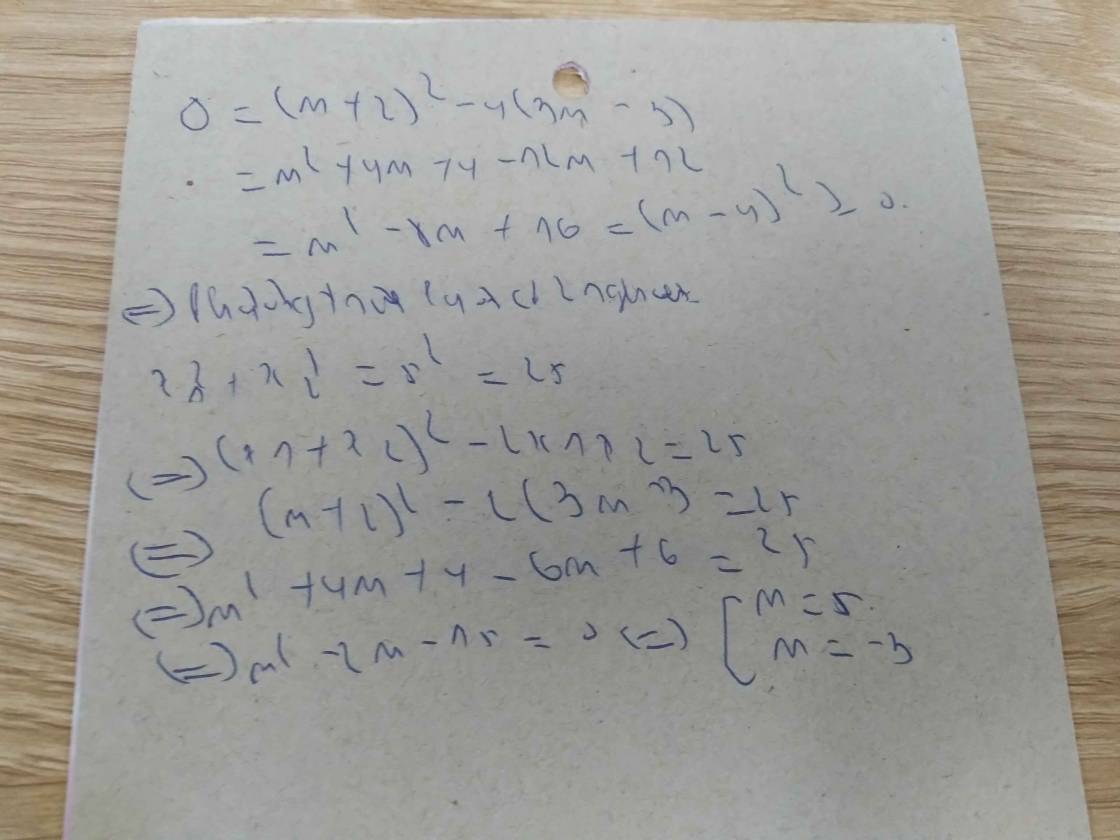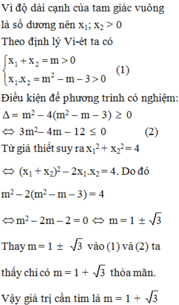Hãy nhập câu hỏi của bạn vào đây, nếu là tài khoản VIP, bạn sẽ được ưu tiên trả lời.

Vì phương trình có 2 nghiệm phân biệt \(x_1,x_2\) nên theo hệ thức VI-ét ta có:
\(\left\{{}\begin{matrix}x_1+x_2=m+5\\x_1x_2=3m+6\end{matrix}\right.\)
Mà \(x_1,x_2\) là độ dài của hai cạnh góc vuông của một tam giác vuông có độ dài cạnh huyền bằng 5 nên ta có:\(\Rightarrow x_1^2+x_2^2=25\Rightarrow\left(x_1+x_2\right)^2-2x_1x_2=25\Rightarrow\left(m+5\right)^2-2\left(3m+6\right)=25\Leftrightarrow m^2+10m+25-6m-12=25\Leftrightarrow m^2+4m-12=0\Leftrightarrow m^2-2m+6m-12=0\Leftrightarrow\left(m-2\right)\left(m+6\right)=0\Leftrightarrow\left[{}\begin{matrix}m=2\\m=-6\end{matrix}\right.\) b Vì phương trình có 2 nghiệm phân biệt \(x_1,x_2\) nên theo hệ thức Vi-ét ta có:
\(\left\{{}\begin{matrix}x_1+x_2=2m-6\\x_1x_2=2m-2\end{matrix}\right.\) \(\Rightarrow T=\left(x_1+x_2\right)^2-2x_1x_2=\left(2m-6\right)^2-2\left(2m-2\right)=4m^2-24m+36-4m+4=4m^2-28m+40=4m^2-28m+49-9=\left(2m-7\right)^2-9\ge-9\) Dấu = xảy ra \(\Leftrightarrow m=\dfrac{7}{2}\)

Đề là \(x^2-\left(m+5\right)x+3m+6=0\) đúng không nhỉ?
a. Ta có:
\(\Delta=\left(m+5\right)^2-4\left(3m+6\right)=m^2-2m+1=\left(m-1\right)^2\ge0\) ; \(\forall m\)
\(\Rightarrow\) Phương trình đã cho luôn có 2 nghiệm với mọi m
b. Theo hệ thức Viet: \(\left\{{}\begin{matrix}x_1+x_2=m+5\\x_1x_2=3m+6\end{matrix}\right.\)
Để \(x_1;x_2\) là độ dài 2 cạnh góc vuông thì trước hết \(x_1;x_2\) dương
\(\Rightarrow\left\{{}\begin{matrix}x_1+x_2>0\\x_1x_2>0\end{matrix}\right.\) \(\Rightarrow\left\{{}\begin{matrix}m+5>0\\3m+6>0\end{matrix}\right.\) \(\Rightarrow m>-2\)
Khi đó áp dụng định lý Pitago:
\(x_1^2+x_2^2=25\Leftrightarrow\left(x_1+x_2\right)^2-2x_1x_2=25\)
\(\Leftrightarrow\left(m+5\right)^2-2\left(3m+6\right)=25\)
\(\Leftrightarrow m^2+6m-12=0\Rightarrow\left[{}\begin{matrix}m=-3-\sqrt{21}< -2\left(loại\right)\\m=-3+\sqrt{21}\end{matrix}\right.\)

Để phương trình có 2 nghiệm:
\(\Delta\ge0\Rightarrow\left[-\left(m+2\right)\right]^2-4.1.\left(3m-3\right)\ge0\\ \Leftrightarrow m^2+4m+4-12m+12\ge0\\ \Leftrightarrow m^2-8m+16\ge0\forall m\)
Theo Vi-et ta có: \(\left\{{}\begin{matrix}x_1+x_2=\dfrac{-\left[-\left(m+2\right)\right]}{1}=m+2\\x_1.x_2=\dfrac{3m-3}{1}=3m-3\end{matrix}\right.\)
x1, x2 là độ dài của một giam giác vuông có cạnh huyền bằng 5.
Theo định lý Py-ta-go ta có:
\(x_1^2+x_2^2=5^2\Leftrightarrow x_1^2+2x_1x_2+x_2^2-2x_1x_2=25\\ \Leftrightarrow\left(x_1+x_2\right)^2-2x_1x_2=25\\ \Leftrightarrow\left(m+2\right)^2-2.\left(3m-3\right)=25\\ \Leftrightarrow m^2+4m+4-6m+6-25=0\\ \Leftrightarrow m^2-2m-15=0\Leftrightarrow\left[{}\begin{matrix}m=5\\m=-3\end{matrix}\right.\)
Vậy...

a: Khi m=3 thì (1): x^2-3x+2*3-4=0
=>x^2-3x+2=0
=>x=1 hoặc x=2
b:
Δ=(-m)^2-4(2m-4)
=m^2-8m+16=(m-4)^2
Để phương trình có hai nghiệm phân biệt thì m-4<>0
=>m<>4
Theo đề, ta có: x1^2+x2^2=13
=>(x1+x2)^2-2x1x2=13
=>m^2-2(2m-4)=13
=>m^2-4m+8-13=0
=>m^2-4m-5=0
=>(m-5)(m+1)=0
=>m=5 hoặc m=-1

cho phương trình x2−(m+2)x+3m−3=0 với x là ẩn, m là tham số
a,Với m = -1 thì pt trở thành
\(x^2-\left(-1+2\right)x+3\left(-1\right)-3=0\)
\(\Leftrightarrow x^2-x-6=0\)
\(\Leftrightarrow\left(x+2\right)\left(x-3\right)=0\)
\(\Leftrightarrow\orbr{\begin{cases}x=-2\\x=3\end{cases}}\)
b, Vì pt có 2 nghiệm x1 ; x2 là độ dài 2 cạnh góc vuông nên x1 ; x2 > 0 hay pt có 2 nghiệm dương
Tức là \(\hept{\begin{cases}\Delta>0\\S>0\\P>0\end{cases}\Leftrightarrow}\hept{\begin{cases}\left(m+2\right)^2-4\left(3m-3\right)>0\\m+2>0\\3m-3>0\end{cases}}\)
\(\Leftrightarrow\hept{\begin{cases}m^2+4m+4-12m+12>0\\m>1\end{cases}}\)
\(\Leftrightarrow\hept{\begin{cases}m^2-8m+16>0\\m>1\end{cases}}\)
\(\Leftrightarrow\hept{\begin{cases}\left(m-4\right)^2>0\\m>1\end{cases}}\)
\(\Leftrightarrow\hept{\begin{cases}m>1\\m\ne4\end{cases}}\)
Theo hệ thức Vi-ét \(\hept{\begin{cases}x_1+x_2=m+2\\x_1x_2=3m-3\end{cases}}\)
Vì x1 ; x2 là độ dài 2 cạnh góc vuông của tam giác vuông có độ dài cạnh huyền bằng 5
\(\Rightarrow x_1^2+x_2^2=25\)
\(\Leftrightarrow\left(x_1+x_2\right)^2-2x_1x_2=25\)
\(\Leftrightarrow\left(m+2\right)^2-2\left(3m-3\right)=25\)
\(\Leftrightarrow m^2+4m+4-6m+6=25\)
\(\Leftrightarrow m^2-2m-15=0\)
\(\Leftrightarrow\left(m-5\right)\left(m+3\right)=0\)
\(\Leftrightarrow m=5\left(Do\text{ }\hept{\begin{cases}m>1\\m\ne4\end{cases}}\right)\)
Vậy m = 5


\(\Delta=\left(m+5\right)^2-4\left(3m+6\right)=m^2-2m+1=\left(m-1\right)^2\ge0\) ;\(\forall m\)
\(\Rightarrow\) Phương trình luôn có 2 nghiệm với mọi m
Theo hệ thức Viet: \(\left\{{}\begin{matrix}x_1+x_2=m+5\\x_1x_2=3m+6\end{matrix}\right.\)
Do \(x_1;x_2\) là độ dài 2 cạnh tam giác nên \(x_1>0;x_2>0\)
\(\Rightarrow\left\{{}\begin{matrix}m+5>0\\3m+6>0\end{matrix}\right.\) \(\Rightarrow m>-2\)
Khi đó, áp dụng định lý Pitago:
\(x_1^2+x_2^2=5^2\)
\(\Leftrightarrow\left(x_1+x_2\right)^2-2x_1x_2=25\)
\(\Leftrightarrow\left(m+5\right)^2-2\left(3m+6\right)=25\)
\(\Leftrightarrow m^2+4m-12=0\Rightarrow\left[{}\begin{matrix}m=-6< -2\left(loại\right)\\m=2\end{matrix}\right.\)